Long wait times harm both your business and your customers. Customers expect fast and effective service, and your agents want fewer recurring inquiries. The key to achieving this is resolving issues on the first attempt. First call resolution (FCR) is the core metric that measures your success in this area and is a clear indicator of the efficiency of your problem-solving process.
In this guide, we’ll discuss FCR in detail, from how to measure it to the best practices for achieving a high resolution rate, freeing up your team’s time, and creating happier, more loyal customers.
What Is First Call Resolution?
First call resolution or FCR is a customer service metric that measures the percentage of customer issues resolved completely within the first interaction, eliminating any need for a follow-up. For an issue to be considered resolved, the agent must solve the customer’s problem so thoroughly that they don’t have to contact the support team again about the same issue.
In the call center industry, FCR is an important metric for evaluating customer service effectiveness. A high FCR rate reflects a positive customer experience, reduced frustration, lower operating costs, and highly efficient customer support.
A common point of confusion is the difference between “first call resolution” and “first contact resolution.”
- First call resolution traditionally refers to resolving issues only on the first phone call.
- First contact resolution is a more modern, comprehensive metric that includes resolving issues on the initial contact across all support channels: phone, email, live chat, social media, and more.
We’ll use the terms interchangeably throughout the article.
Why Is First Call Resolution Important?
A landmark study from Forrester Research has shown that companies that lead in customer experience (CX) outperform their competitors in stock market returns and long-term growth. FCR is a foundational element of that leading experience.
Tracking and improving FCR is one of the most powerful actions for customer-centric businesses. Loyal and satisfied customers are often the result of successful first call resolution. Here are some benefits of using FCR as a contact resolution metric.
Enhances customer satisfaction
Improving FCR directly improves customer satisfaction by reducing the need for repeat contacts and enabling faster resolution. Understanding customer needs leads to a better overall customer experience. SQM Group’s call center CX study shows that for every 1% improvement in FCR, customer satisfaction (CSAT) also increases by 1%.
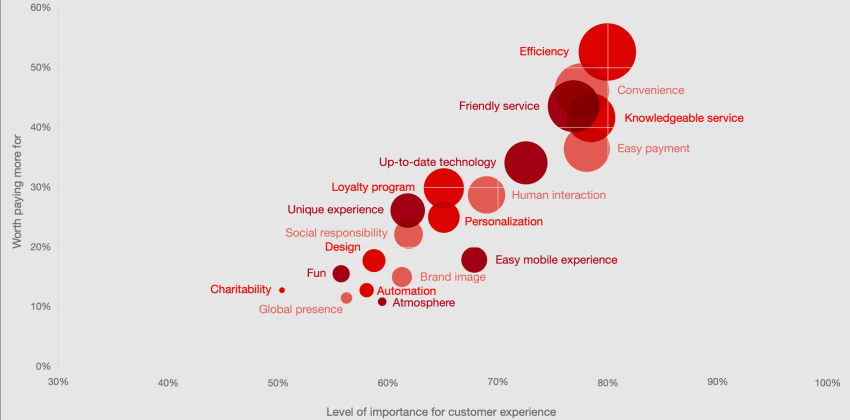
Reduces operational costs
Efficient, one-touch resolutions are cost-effective. A higher FCR reduces the volume of expensive repeat calls, emails, and chats. According to SQM Group, for a typical midsize call center, a 1% improvement in FCR can cause $286,000 in annual operational savings and an improved bottom line.
Len Markidan, Ex Marketing Head at GrooveHQ, famously puts it:
“If you handle 1,000 interactions per week, and your average first contact resolution rate is 70%, that means that 30% of your tickets require multiple responses. Increasing your typical first contact resolution rate by just ten points to an 80% success rate means you’ll send at least 300 fewer emails per week or 15,600 per year.”
Improves loyalty and customer retention
A smooth customer service experience is a powerful retention tool. Renowned customer experience expert Matt Dixon states, “Resolving a customer’s issue on the first contact is the single greatest driver of customer loyalty.” When customers get their problems solved with minimal effort, they’re far more likely to remain loyal, generate referrals, and continue doing business with your company.
Boosts agent morale and reduces turnover
Constantly fielding calls from frustrated customers who have had to contact your support team multiple times leads to stress and agent burnout. A low FCR means poor customer service, higher customer churn, and negative business results.
A Harvard Business Review article on employee motivation emphasizes the power of progress. Agents who consistently resolve issues on the first call feel more accomplished and motivated, which, in turn, improves job satisfaction.
Provides actionable insights
Tracking FCR provides insights beyond your call center’s performance, covering the entire customer journey. Think of each repeat contact as a warning sign, indicating a friction point where the problem-resolution process failed.
Understanding the reasons for these follow-up contacts — whether it’s a confusing invoice or a broken link on your website — you can turn raw FCR data into a detailed overview that shows the biggest obstacles in your customer experience. This customer-centric view allows you to look ahead to find the root cause of problems, which often lies outside the support team.
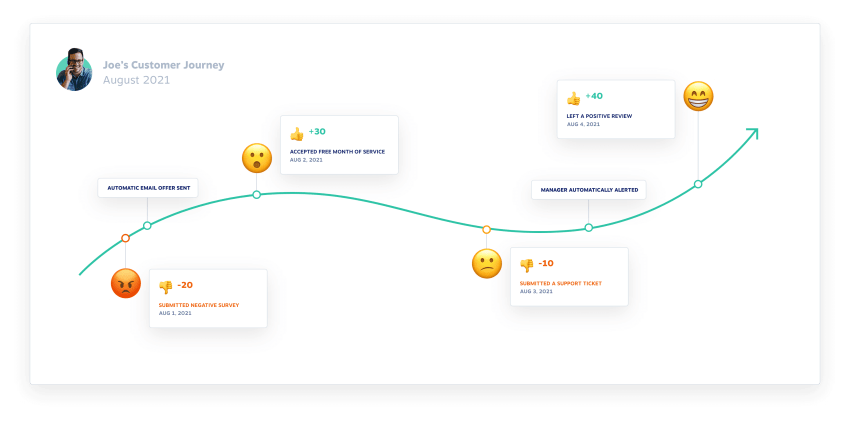
How to Calculate and Measure First Call Resolution
The formula to calculate the first call resolution rate is straightforward:
(Number of issues resolved on first call / Total number of customer contacts) x 100 = FCR Rate %
For example, if your contact center handled 5,000 total inquiries last month and 3,750 of them were resolved without needing a follow-up, your calculation would be:
(3,750 / 5,000) x 100 = 75% FCR Rate
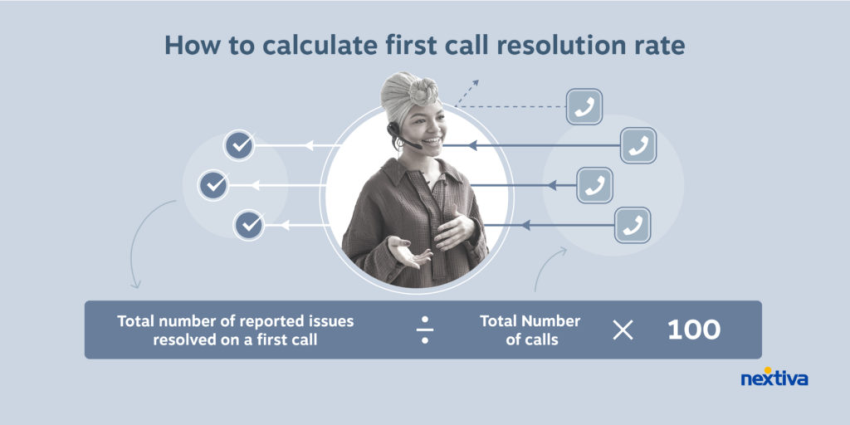
To get an accurate picture, have a clear, internally-agreed-upon definition of what constitutes a “resolved” issue and what the time frame is for a “repeat” contact (e.g., 7 days, 14 days). The most accurate FCR measurement combines data from your contact center software and post-interaction customer surveys.
Measuring FCR helps make targeted, data-driven improvements across your businesses, creating a smoother customer journey that prevents problems from occurring in the first place.
What Is a Good FCR Rate? Industry Benchmarks
A widely accepted industry standard is between 70% and 79%. The average call center typically achieves a first call resolution rate within this range, though results can vary based on industry benchmarks and operational factors. A rate of 80% or higher is considered world-class.
However, performance can also differ significantly by channel. Here are some general benchmarks:
- Phone calls: 70-75%
- Live chat: 55-65%
- Email: 60-70%
- Self-service (chatbots, FAQs): 30-50%
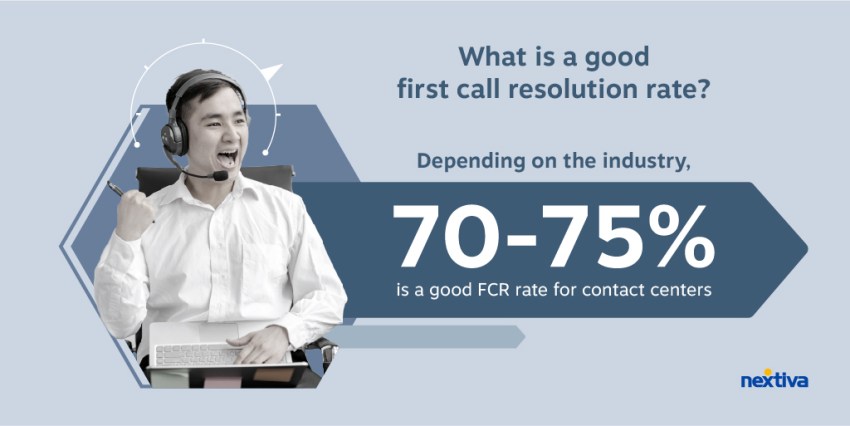
Call complexity also affects FCR rates. More complex issues are harder to resolve on the first contact, leading to lower first call resolution metrics across certain channels.
The most important approach isn’t to simply achieve a static FCR rate, but to focus on continuous improvement by benchmarking it against your past performance.
Common Challenges That Lower FCR
Even with the best intentions, several roadblocks can stand in the way of achieving a high first call resolution rate.
- Information silos: Agents lack access to the necessary information to resolve an issue because it’s stored in a different department’s system. Inefficient communication channels and unclear contacts can hinder agents’ ability to tackle requests on the first call, negatively impacting FCR.
- Complex or multi-step issues: Some problems, like complex insurance claims or technical troubleshooting, require multiple steps and follow-ups. High call complexity leads to multiple calls or the need for a second call to fully resolve the issue, which can lower FCR benchmarks.
- Inadequate agent training: A lack of in-depth product knowledge or process understanding leads to escalations and repeated calls.
- Pressure to lower handle time: Agents pressured to end interactions deliver incomplete solutions, prompting customers to contact support again.
It’s critical to balance efficiency with effectiveness.
8 Best Practices to Improve First Call Resolution
Improving FCR requires a multifaceted approach. Here are eight best practices for better first contact resolution.
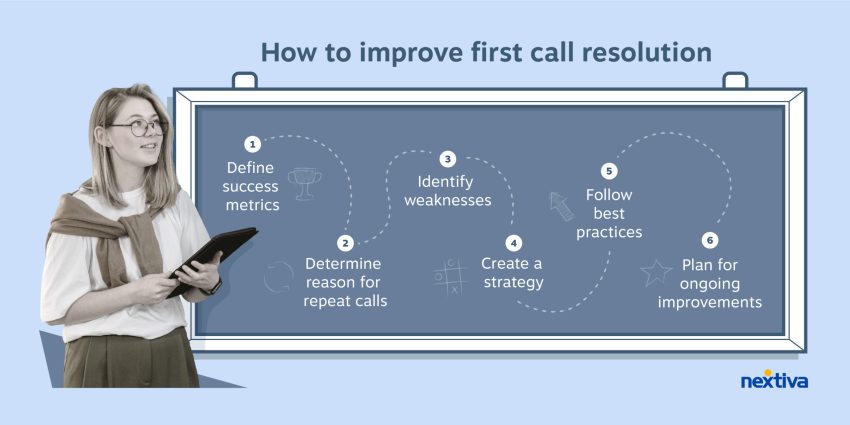
1. Empower your agents with knowledge and authority
Agents can’t resolve issues if they don’t have the right information or the power to make decisions. Invest in a centralized, easy-to-search knowledge base and provide clear guidelines on what they’re authorized to do without needing to escalate.
One of the most famous examples of employee empowerment is The Ritz-Carlton’s policy, which allows any employee to spend up to $2,000 per guest, per day, to resolve customer problems or improve a guest’s stay, without seeking a manager’s approval. This embodies the principle of trusting frontline staff to make financial decisions to ensure satisfaction.
2. Implement an ongoing training program
Agent training is essential. This includes not only product knowledge but also soft skills like active listening, empathy, and de-escalation techniques. Train your support department using role-playing to practice handling complex or unexpected scenarios.
You can also use recordings of both high-FCR and low-FCR calls as training modules. Let agents listen and discuss what went right and what could be improved, turning real interactions into learning opportunities.

3. Analyze interactions to identify root causes
To understand why issues aren’t resolved on the first try, analyze customer interactions from two angles:
- Listen to customer feedback: Use post-call surveys, email responses, or social media to ask customers directly if their issue was resolved. This provides immediate, direct insight into where processes are failing or where agents require additional training.
- Record and monitor calls: Regularly review call recordings and transcripts to identify the root causes of repeat contacts. Quality assurance helps you spot trends, such as unclear internal processes or technical bugs, that customers may not explicitly report.
Combining direct feedback with internal analysis can help you proactively address the core issues that lead to repeat contacts and make targeted improvements.
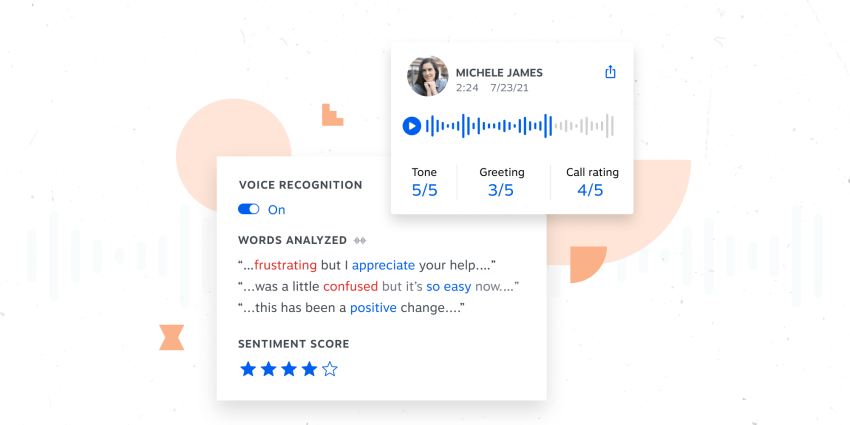
4. Use technology to your advantage
Call center tools are vital to setting and achieving FCR benchmarks and driving better customer outcomes.
- Intelligent routing: Use skills-based routing and omnichannel support to immediately connect customers with the call center agent best equipped to handle their specific issue on their preferred channel.
- Speech analytics: Voice analytics automatically analyzes interactions to identify friction points and agent coaching opportunities. According to an Aberdeen study, businesses that use speech analytics achieve an average FCR of 76%, compared to just 23% for those that don’t.
- Customer relationship management (CRM) systems: Integrate CRM tools to give call center agents a unified view of the customer’s history, enabling them to track previous interactions and resolve issues more efficiently.
- Interactive voice response (IVR) systems: Implement IVR technology to automate call routing and gather essential information before connecting customers to agents, reducing wait times and increasing the likelihood of resolving issues the first time.
- Customer service portal: Provide a centralized customer service portal for tracking and documenting all customer interactions, such as tickets, calls, and emails, to streamline workflows and support better first contact resolution.
Keep a tab on the latest customer service solutions. AI agent assist tools are an emerging trend that automatically advise agents on the next best steps.
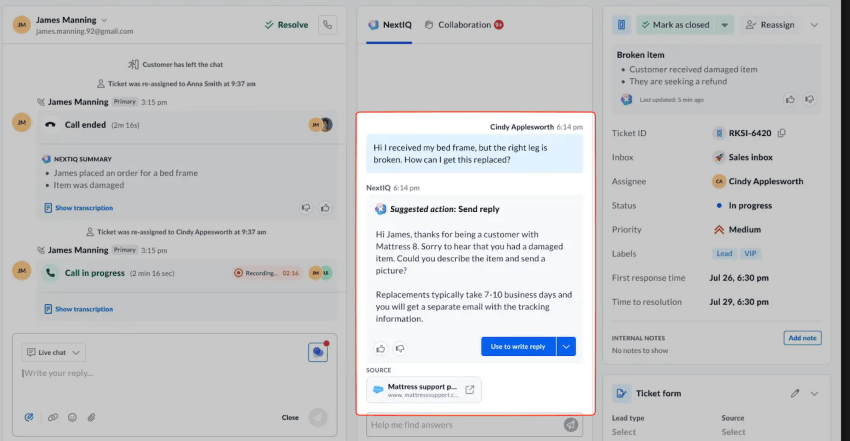
5. Optimize self-service options
An FAQ page, a full knowledge resource, and effective chatbots can deflect simple customer requests, helping customers resolve common issues on their own and freeing agents to focus on more complex issues that are less likely to be resolved on the first try. Ensure your self-service tools are accurate and easy to use.
Instead of just a text-based FAQ, create short, two-minute video tutorials for the top 5 most common “how-to” questions. This caters to different learning styles and can resolve issues more effectively than text alone.
6. Create a collaborative, team-based culture
Collaboration among customer service team members helps resolve issues faster and better. Build a culture where agents feel comfortable asking for help from colleagues or supervisors. Create clear escalation paths so a stuck agent can quickly escalate their issue to someone who can resolve it.
A good practice is to implement a dedicated Slack or Teams channel where agents can post questions in real-time. Often, a peer who just handled a similar issue can provide an immediate answer, preventing the need for a callback or escalation.
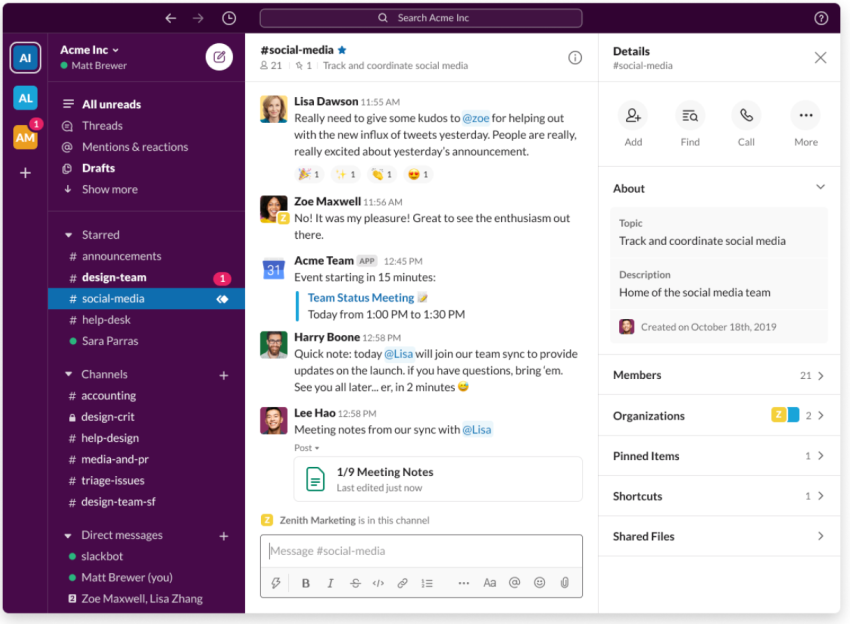
7. Set clear customer expectations
Discuss complex issues requiring multiple interactions openly. Communicating a clear resolution path and timeline can avoid customer frustration and manage their expectations, even if first contact resolution isn’t possible in the specific case.
An agent dealing with a complex warranty claim could say, “This will require our technical team to investigate. I’m opening a ticket for you now, and I’ve scheduled a follow-up call for you tomorrow at 10 AM with the update. Your ticket number is…” This manages expectations and provides a clear path forward.
8. Measure FCR performance and incentivize success
Track first call resolution rates at the individual, team, and center level. Use agent performance data not to punish, but to identify coaching opportunities. Use post-call surveys to measure and benchmark FCR rates. Gather direct customer feedback to evaluate customer service performance and compare results across industry standards. Also, consider tying performance incentives to first call resolution and overall customer satisfaction scores to align your team around the same goal.
Financial services firms, for example, can shift agent incentives. Instead of rewarding agents purely for low call times, they can create a balanced scorecard where FCR and CSAT scores are weighted just as heavily. This will encourage agents to focus on the quality of the resolution, not the speed of the call.

Make FCR Your Customer Experience Superpower
FCR isn’t just another metric to track — it’s a core component of a customer-centric business strategy. When you resolve customer requests quickly and effectively, you reduce customer effort, build trust, and create seamless experiences that turn customers into lifelong advocates.
Ready for higher FCR rates? Nextiva’s cloud call center solutions provide the tools to empower your agents and delight your customers.
- Effortless tracking: Monitor FCR and other critical KPIs with built-in conversation intelligence.
- Actionable insights: Pinpoint problem areas for targeted improvements with advanced voice and interaction analytics.
- Empowered agents: Give your team the real-time data and unified customer views to make smarter decisions.
- Maximized efficiency: Use intelligent routing to handle more interactions with greater accuracy.
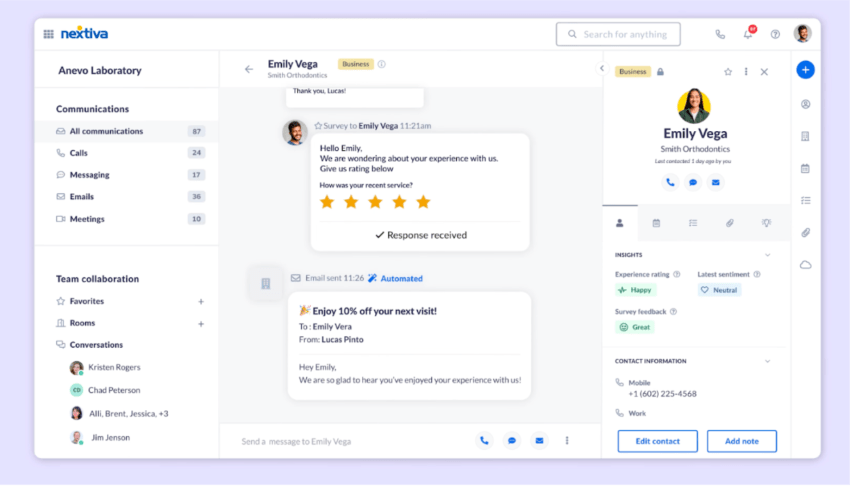
Get a cloud contact center solution from Nextiva.
IVR, call recording, VoIP numbers, call routing, advanced reporting–integrated in ONE cloud platform.
Frequently Asked Questions (FAQs)
FCR has a direct and positive impact on most other important KPIs. A high FCR typically leads to:
– Higher customer satisfaction (CSAT) and net promoter score (NPS)
– Lower customer effort score (CES)
– Lower operational costs and cost per call
– Improved customer retention
Initially, focusing on FCR might slightly increase average handle time (AHT) as agents spend more time on a thorough resolution, but this is a worthwhile trade-off for higher satisfaction and lower repeat contact rates.
While FCR is critical, it should be viewed as part of a balanced scorecard that includes:
– Customer satisfaction (CSAT)
– Customer effort score (CES)
– Average handle time (AHT)
– Agent satisfaction (ASAT)
– Call containment rate (for IVR and self-service)
These contact center metrics are essential for tracking and improving FCR, ensuring your team delivers effective customer service.
First call resolution refers to successfully resolving an issue within the first live interaction with an agent. Call deflection, on the other hand, is preventing a live interaction from happening in the first place by enabling customers to solve their own issues through self-service channels like a knowledge base, FAQ page, or chatbot. Both are strategies to improve efficiency and customer experience.

















 Customer Experience
Customer Experience 










